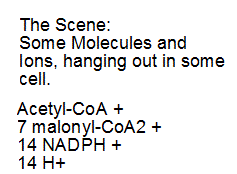"Cellular Metabolism" is all the hundreds of coordinated chemical reactions that cells use to convert "raw materials" into the energy and complex organic molecules they need to survive.

Cellular metabolism is a huge production. In every moment each of the trillions of cells in your body is carrying out thousands of chemical reactions (1), using the food you eat, the water you drink and the air you breathe to power all your bustling about and to build and maintain your body.
In metabolism, your cells use enzymes to precisely control the complicated multi-step chemical reactions that keep you alive.
There are two main parts to metabolism: catabolism and anabolism.
In catabolism, larger molecules are broken down into smaller molecules, releasing energy. In anabolism, smaller molecules are combined together to make larger molecules, consuming energy.
Without any encouragement, the chemical reactions cells need to stay alive wouldn't happen fast enough. You can generally speed up the rate of chemical reactions by turning the temperature up. However, that wouldn't work for cells because they can't handle much heat.

Luckily, we've got enzymes. "Enzymes" are protein molecules (or once in a while RNA molecules) that fit very precisely to very specific molecules, creating a new temporary molecule that is much more likely to react in the desired way than the original molecule was.
The end result is that without adding any extra energy, enzymes cause chemical reactions to happen much more quickly than they would have on their own (2). This speeding–up of chemical reactions is called "catalyzing reactions".
After the enzymes have done their job, they're released and are free to catalyze another reaction.
Catalyzing specific reactions in specific sequences is a big part of how our genetic code (which determines what enzymes are made) controls the destiny of our cells and bodies (see definition of life).
When I say that enzymes "speed up" the rate of reactions in our cells, I mean "really really speed up." Some of the enzymes in our body increase the rate of their targeted chemical reactions by 1016 (that's 10,000,000,000,000,000) times! (3)
Catabolism (breaking larger molecules down into smaller ones) is important for several reasons:
(1) Catabolism breaks large complex molecules into smaller, simpler molecules that can then be used (in anabolism) as building blocks for the more complex molecules that cells need to build and repair themselves.
(2) Catabolism also frees up vitamins and minerals. These are substances that cells require in small amounts but cannot make themselves. Vitamins are organic molecules (example: Vitamin C—C6H8O6). Minerals are inorganic ions (example: calcium ions—Ca2+).
Finally,
(3) during catabolism energy is released. And, (still during catabolism),
(4) The released energy is immediately used to make energy–transfer molecules.
Energy–transfer molecules are high–energy molecules that are a type
of cellular "fuel" that can be easily transported throughout a cell, and whose stored energy
can quickly and easily be released and made to drive chemical reactions that require energy.
As mentioned above, some of the cellular reactions that consume energy are the molecule–building reactions of anabolism. In this way you can see that if the two halves of metabolism were brothers, catabolism might be considered the "hard–working" one who earns all the money (energy), while anabolism might be called a "spend-thrift" who just uses money (energy) up.
However, that wouldn't be quite fair. Some of the molecules anabolism builds are used by cells for long–term energy storage (like fats in animals and carbohydrates in plants). The energy–transfer molecules made during catabolism are used up soon after they're made, so without anabolism, the brothers would never put any money (energy) away for later. Who's the spendthrift now? Anyway, what good is money (or energy) if you never spend it?. [Source for info about energy–transfer molecules: 4.]

The two most important of the energy–transfer molecules are ATP and NADPH. Both are made (in catabolism) with the energy released from oxidation–reduction reactions.
ATP is used to supply energy for all sorts of things, including the molecule–building work of anabolism. NADPH is used as a "reducing agent" (this term is explained on the NADPH page) in the oxidation–reduction reactions of anabolism.
As we'll see on ATP, every day the average adult makes and consumes an amount of ATP equal to his or her body weight. And you thought you were just hanging around doing nothing!
To see how the energy released by the molecule–busting catabolism is used to create ATP and NADPH and how these molecules are used to power other cellular activities including the molecule–building work of anabolism, go to the next page on cellular metabolism, ADP and NADPH.
For a definition of "oxidation–reduction" reactions, see oxidation–reduction.
Gratitude to the Unknown Instructors
If this page has been a help to you
please recommend it with Google+ below:
1 There are two facts here: (1) the number of chemical reactions carried out each instant by the cells in your body and
(2) the number of cells in your body.
(1) "in every moment all ... the cells in your body are carrying out thousands of chemical reactions": this fact comes from the beginning
of Chapter 14 of the second edition of the textbook Biochemistry by Garrett and Grisham, currently (6/20/2011) available online at
Heidi.
(2) There are trillions of cells in your body: this came from the press release for "The Nobel Prize in Physiology or Medicine 2001" that
went to Leland H. Hartwell, Tim Hunt, Sir Paul Nurse "for their discoveries of 'key regulators of the cell cycle'"; In this press release,
it was stated: "An adult human being has approximately 100 000 billion cells..." So, an average adult has about 100 trillion cells. Younger people
have less but still trillions since—if you are old enough to be reading about cell metabolism—it is unlikely that you weigh 1/100th as much
as the average adult. In fact, now that I think about it, it is unlikely that if you are out of the womb, you are that slight. The
press release is currently (6/20/2011) online at laureate press release.
2 Information about the working of enzymes can be found in "14.2 "Introduction to Enzyme Kinetics" of the textbook (Biochemitry by Garrett and Grisham) discussed and linked-to in the first part of footnote #1. Particularly relevant to our discussion here is the subsection "Decreasing DG Increases Reaction Rate" in which we find, "Catalysts work by lowering the energy of activation rather than by raising the average energy of the reactants. Catalysts accomplish this remarkable feat by combining transiently with the reactants in a way that promotes their entry into the reactive, transition-state condition." An explanation of transition-states is found in the subsection "Free Energy of Activation and the Action of Catalysts": "In a first-order chemical reaction, the conversion of A to P occurs because, at any given instant, a fraction of the A molecules has the energy necessary to achieve a reactive condition known as the transition state. In this state, the probability is very high that the particular rearrangement accompanying the A -> P transition will occur."
3 This fact also comes from Biochemistry discusssed and linked-to in the first part of footnote #1. Specifically, it is at the beginning of section 14.1 "Enzymes-Catalytic Power, Specificity, and Regulation".
4 "Energy-transfer molecules" are discussed throughout the textbook Biochemistry (see footnote #1 for
details about this book) where they go by the name "high-energy biomolecules".
In section "3.6 "The High-Energy Biomolecules", these molecules are introduced and we learn,
"A small family of universal biomolecules mediates the flow of energy from exergonic reactions to the energy-requiring
processes of life. These molecules are the reduced coenzymes and the high-energy phosphate compounds." In that section,
they also point out that these two molecules are not used for long-term storage, but rather,
"They are transient forms of stored energy, meant to carry energy from point to point,
from one enzyme system to another, in the minute-to-minute existence of the cell."